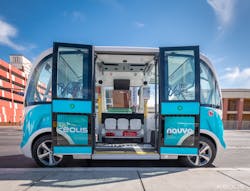Mobility Meets Sustainability: The Push to Integrate Smart City Tech into North America’s Transit Systems
On the quest to provide more effective and environmentally sound transportation service options, we’ve seen transit agencies in North America explore a plethora of ways to incorporate new technology into smart cities. Over the past two years specifically, these agencies have integrated the ‘Internet of Things’ into their networks, services, and overall operations.
Cities and governmental agencies, both in the United States. and Canada, are collaborating with global organizations and forward-thinking companies like Keolis to maximize existing operations while incorporating newer options for safe, streamlined services.
In this piece, we’ll explore some of the major ways Keolis, a global leader in public transportation, and smart city technology have contributed to the way we move from day to day.
Las Vegas on the Move: Keolis Launches the First Autonomous Shuttle in the U.S.
In November 2017, Keolis and NAVYA launched a fully autonomous electric shuttle pilot program to operate on open roads in Las Vegas, Nevada. This self-driving electric shuttle is the first autonomous public transit vehicle in North America to be fully integrated into an open road with mixed-use traffic. Additionally, the Keolis shuttle is helping to make Las Vegas a “smart city” by communicating with traffic signals, which improves safety and helps to realize efficiencies in traffic flow. The Keolis autonomous shuttle is equipped with LiDAR technology, GPS, cameras, and safety belts and is designed to communicate with traffic signals, operate on open roads and navigate around pedestrians and other moving traffic.
Keolis, NAVYA and the American Automobile Association (AAA) partnered with the City of Las Vegas and the Regional Transportation Commission of Southern Nevada (RTC) to launch a downtown autonomous shuttle route connecting local commuters and visitors to multiple retail, business and transit locations in the Freemont Innovation District.
In addition to studying how the shuttle interacts in a live traffic environment in downtown Las Vegas, AAA surveyed riders to understand why many consumers remain wary of driverless technology and whether a personal experience changes their perception. The surveyed riders to date indeed showed skepticism before riding the shuttle, but that sentiment nearly instantly changed once they utilized the shuttle service. To date, more than 32,000 people have traveled on the autonomous shuttle in downtown Las Vegas.
Creating Sustainable Mobility
At the 2018 Consumer Electronics Show (CES) - recognized as the world’s largest technology innovation show - Keolis partner NAVYA introduced the first fully autonomous taxi in North America, AUTONOM CAB. The all-electric-powered AUTONOM CAB is an intelligent transport service designed for private or shared trips for up to six passengers in urban centers. Users can order an AUTONOM CAB through a dedicated smartphone application and open and close the vehicle’s door via the application.
The move toward incorporating technology for sustainable mobility options can also be seen in the Greensboro Transit Authority’s (GTA) plan to replace vehicles in its 48-bus fleet with electric Proterra buses. Keolis will be operating GTA’s fixed-route bus and paratransit services starting in January 2019 as electric Proterra buses start to replace vehicles in the 43-bus fleet. By March 2019, 14 electric buses will be in operation, while the city aspires eventually to have a fully electric fleet.
Canada in Transit: The First Automated Electric Shuttle is Introduced
In August 2018, Keolis Canada and partner NAVYA launched the first long-term demonstration project of an all-electric autonomous shuttle operating on public roads in Candiac, Canada.
The autonomous shuttle will spend 12 months (including 4 months of a research and development project to test the shuttle in Quebec’s cold weather conditions without passengers on board) operating in the city of Candiac (south shore of Montreal) on a 2 kilometer route on public roads mixed with traffic.
Like all NAVYA AUTONOM shuttles, the vehicle does not have a steering wheel or pedals. It is designed to operate on a predetermined route at inner-city traffic speeds with frequent stops to accommodate high-traffic pedestrian areas and connect with other transit center facilities.
One of the main objectives of integrating the autonomous shuttle into urban areas is to ease public transit by providing the interconnection between the shuttle and the bus terminal to take employees to their workplaces and visitors to their destinations. The shuttle also includes additional stops such as the city hall, retirement housing, and an array of local businesses.
The Keolis Shuttle is supported by the Quebec Government, the Technopôle IVEO, and Propulsion Quebec, the Cluster for Electric and Smart Transport. The prospect of gaining critical insights into extending service, maintaining harmony between other vehicles on the road, and understanding public acceptance or dissent prompted Quebec’s Ministry of Economy, Science, and Innovation to provide $350,000 in financial support for this demonstration project.
Micro Transit On-Demand
The Orange County Transportation Authority (OCTA) launched its on-demand microtransit pilot program, OC Flex, to provide public transit to some of the most underserved areas in the city. The pilot project, operated by Keolis, ensures that passengers are able to easily access all public transportation options in their region and will connect to the OC Bus network and Metrolink commuter rail stations. It will initially serve two zones of approximately six to eight square miles, with the potential to expand into additional zones, allowing passengers to hail rides from their smartphones and track the status of their trips.
Modern Transit, Modern Management
Keolis is also applying insights in smart city technology to modernize its transportation management projects. The company utilizes drones to conduct safety inspections of railroad tracks to detect potential hazards much sooner and more efficiently than traditional inspection methods.
Smaller changes such as the Virginia Railway Express (VRE) mobile ticketing app, VRE Mobile powered by GlobeSherpa, are adding up to greater user satisfaction by allowing passengers to buy and use tickets and multiple-day passes on their iPhones and Androids. In Boston, a reverse commute and discount fare program was recently launched to encourage ridership on the commuter rail during off-peak commuter routes and during special events like a Patriots or Red Sox baseball game. By taking this approach, Keolis is introducing the benefits of public transportation while reducing vehicle traffic, congestion and protracted commute experiences.
As we incorporate new technology into traditional transit systems, we provide a more cost-efficient, integrated and environmentally friendly experience. These new transportation modes can be layered on top of legacy transportation networks to allow them to be nimbler and more sustainable. Ultimately, as these services expand and technological innovations become more widely utilized, the global transportation landscape will continue to evolve to meet passenger needs.

Chris Barker | Secuvant Executive Board Member, Transportation & Smart Cities Advisor
Chris Barker is a veteran of the global technology and transportation industry with more than 20 years of experience. He is the founder of the technology and transportation consulting firm CBC, where he has worked with industry companies, cities and governments around the world to advance new forms of mobility, energy services and city development projects. Barker is currently a transportation/smart cities advisor for the Cities Today Institute, helping cities worldwide with transportation infrastructure and autonomous surface transportation planning. In 2016, Barker was an advisor to Vulcan on the USDOT Smart City Challenge project and had continued to advance smart city/transportation development projects across the globe. His CBC team has also developed and deployed self-driving car simulators for state DOTs/DMVs, universities, museums and other public facilities – to teach the public about self-driving vehicles.
Barker was previously the vice president of New Mobility at Keolis, helping introduce new transportation options to cities and communities across North America. Keolis provides heavy rail, light-rail, bus, autonomous shuttles and taxis, car share, bike share and sky tram service to 26 countries, moving 3.5 billion people a year. Barker helped launch the first autonomous/electric shuttle operations on open roads in North America – in downtown Las Vegas and Montreal. He’s also played a lead role in helping multiple US cities migrate their transit systems to electrified transit fleets with electric bus conversions in Southern California, Nevada, and South Carolina.
Prior to Keolis, Barker held senior business leadership positions with multiple Fortune 50 companies. He served as the Global Director of Business Development and Communications for Honeywell Aerospace, Head of Public Sector Business Development, Communications and Marketing at Cisco, and Senior Executive Manager for the Office of the President at Boeing. He’s also been a VP/SVP of business development and marketing for Text 100 Communications and Waggener Edstrom Worldwide.
Barker is a National Board Member for the Association for Commuter Transportation. He’s also a global keynote speaker on topics ranging from smart cities and new mobility services to cybersecurity, alternative energy options, and advancements in artificial intelligence. He’s previously been a featured speaker at CES (Las Vegas), SXSW (Austin), RSA (San Francisco), CE Week (New York), A-Bace (Shanghai), and IAA (Frankfurt).

